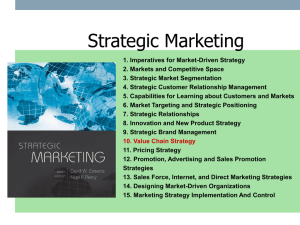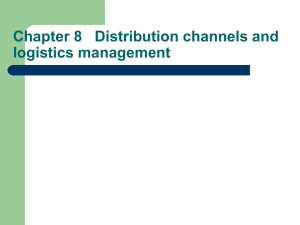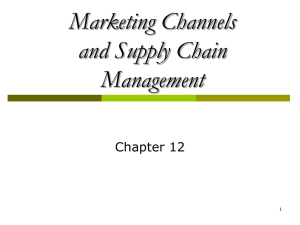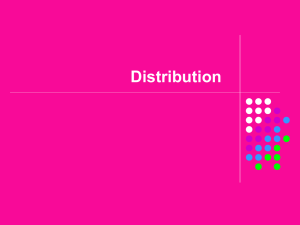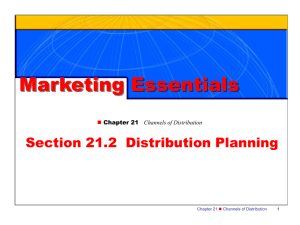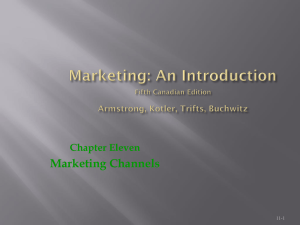International Operations Management
advertisement
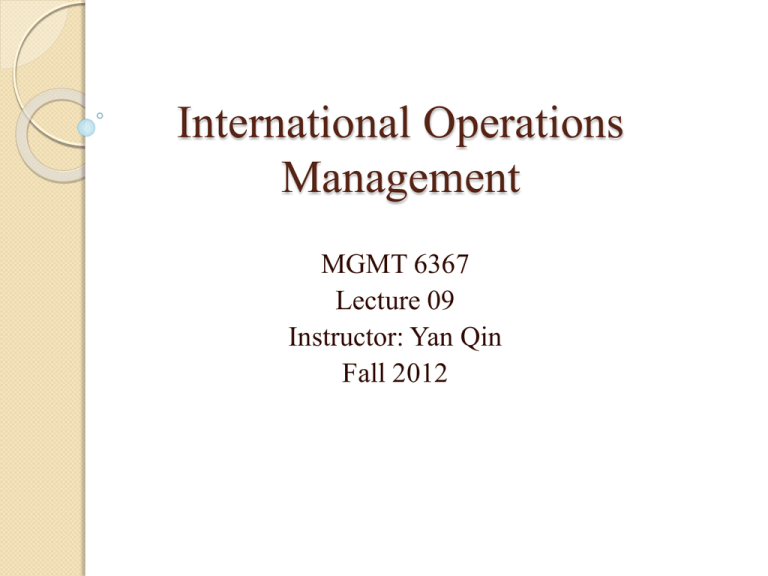
International Operations Management MGMT 6367 Lecture 09 Instructor: Yan Qin Fall 2012 Outline What is a distribution channel? Importance of distribution channels Pros and Cons of using channel members Two key decisions in designing distribution channels: Length; Breath How to select a channel member? New trends in designing distribution channels Case study: 7-11 Japan Co. Distribution Distribution is the process of getting products from the manufacturer to the ultimate customer. Distribution is important because: It affects sales. It affects profits and competitiveness. Delivery is part of customer satisfaction. Distribution decisions Distribution decisions include: Assessing the best distribution channels for getting products to customers Determining whether a reseller network is needed to assist in the distribution process Arranging a reliable ordering system that allows customers to place orders Creating a delivery system for transporting the product to the customer What is a distribution channel? A distribution channel consists of a set of interdependent organizations—such as wholesalers, retailers, and sales agents—involved in making a product available for use or consumption. Distribution channels Three general situations: Companies, such as Dell, sell directly to customers. Companies sell through retailers only. Companies sell through distributors and retailers. Importance of distribution channels The design of distribution channels is one of most important marketing decisions as It affects every other element of a manufacturer’s marketing strategy. Channel choices commit to a company for a relatively long time. Questions to think about As noted in the definition, a manufacturer often requires the assistance of others in order to reach its target market. Now think about the following questions: Why exactly does a company need others to help with the distribution of their products? Wouldn’t a company that handles its own distribution functions always be in a better position to exercise control over product sales and potentially earn higher profits? Benefits of using a channel member Cost savings in specialization Members of the distribution channel are specialists in what they do and can often perform tasks better and at lower cost than companies who do not have distribution experience. Reduced delivery time Channel members are often able to perform their job more rapidly resulting in faster product delivery. Customers want to conveniently shop for variety Benefits of using a channel member Wholesalers and retailers sell smaller quantities They allow customers to buy quantities that work for them. Manufacturers, however, prefer to ship products in large quantities to be more cost effective in distribution. Create sales Channel members dealing customers directly may help create demand for a particular product through their own advertising efforts. Easier market penetration by selling through a local retailer. Costs of using a channel member Loss of revenue Wholesalers and retailers are not likely to offer services to a manufacturer unless they see financial gains in doing so. Loss of communication control Loss of product importance If a competitor is using promotional incentives in an effort to push their product through the same channel members, the manufacturer’s product may not get the attention the manufacturer feels it should receive. Three key considerations When choosing a particular distribution strategy, a manufacturer must balance three primary considerations: Efficiency: Getting products and services to retailers and/or end customers at the lowest cost; Effectiveness: Market coverage and quality of services provided; Control: Ability to determine timing and focus of distribution efforts. Two key decisions in channel design Determining the length of a distribution channel. That is, how many types of channel members should be involved in moving the product from the manufacturer to the ultimate customer. Determining the breath of a distribution channel. That is, how many of each type of channel members should be included in the channel. Length Vs. Breath Other organizations involved in the moving of a product from a manufacturer to the ultimate customer are called third-parties or intermediaries. Each layer of intermediaries is a "channel level". Length refers to the number of layers in a channel, while breath refers to the number of intermediaries at a layer. Length of a distribution channel Some examples of channel levels in distribution: Channel 1: Channel 1 is called a “Direct-marketing” channel since it has no intermediaries involved. The manufacturer sells products directly to consumers. Length of a distribution channel Channel 2 Channel 2 consists of one layer of intermediaries, which are usually retailers. It is an in-direct marketing channel. Length of a distribution channel Channel 3 Channel 3 consists of two layers, Wholesaler(s) and Retailer(s). This is also an indirect-marketing channel. Length of a distribution channel Channel 4 There can be some other layers in a distribution channel. Foreign manufacturers may employ long distribution channels which may include exporters/importers. Characteristics of short and long distribution channels Short channels Long channels Market factors Business users; Geographically concentrated; Extensive technical knowledge and regular service required; Large orders. Consumers; Geographically dispersed; Little technical knowledge and regular service not required; Small orders. Product factors Perishable; Complex; Expensive Durable; Standard; Inexpensive Manufacturer factors Manufacturer has adequate resources to perform channel functions; Broad product lines; When channel control is important. Manufacturer lacks adequate resources to perform channel functions; Limited product line; When channel control in relatively unimportant Indirect distribution channels If a manufacturer decides not to sell directly to its customers, it has two options: Take part in a Conventional system in which the manufacturers uses independent intermediaries to move products to customers. Construct a Vertical Marketing System (VMS) in which manufacturers, wholesalers, and retailers act as a unified system. One channel member owns the others, has contracts with them, or has so much power that they all cooperate. Conventional systems A conventional system tends to be fragmented. None of them has too much control over the others. Reasons for participating a Conventional system: The manufacturer believes that those intermediaries can perform more efficiently than themselves. The manufacturer cannot afford the cost of establishing its own distributorship. The manufacturer want to avoid the risk by having other members in the channel take title to the product. Vertical Marketing System A VMS can be dominated by the manufacturer, wholesaler, or retailer. There are three major types of vertical marketing systems: Corporate VMS: A VMS that combines successive stages of production and distribution under single ownership—channel leadership is established through common ownership. Contractual VMS: a VMS in which independent intermediaries join together through contracts. Administered VMS: a VMS that coordinates the system, not through common ownership or contractual ties, but through the size and power of one of the channel members. Corporate VMS In a Corporate system, a company can exert tight control over marketing activities due to ownership. For example, it allows Hart, Schaffner and Marx to set and maintain its list price on men's clothing. Oil companies to control the quality of the gasoline pumped at their service stations. Goodyear to achieve better coordination in executing its promotional campaign. Corporate VMS – Cons. Big financial investment For example, the US Pioneer, which sells hi-fi audio components, figures it will need fixed investments of $100,000 to establish a wholly owned distributorship, and another $100,000 to open a small hi-fi specialty store of its own. Less flexibility Contractual VMS Franchising prevails in contractual systems. Two types of franchising arrangements: Product trade-name franchising, in which the franchisee acquires the right to market the franchisor's product within a designated market area. Business format franchising, in which the franchisee acquires the right to utilize the business know-how accumulated by the franchisor. Administered VMS In an Administered VMS, the channel member that wields the most economic power within the channel can force greater cooperation and support from other members. Manufacturers of a top brand, such as P&G, can obtain strong trade cooperation and support from resellers. Large retailers such as Wal-Mart can exert strong influence on the manufacturers that supply the products they sell. Breath of distribution channels A company has three options when determining the relative intensity of market coverage: Seek intensive distribution in as many available outlets as possible in a given market area; Seek selective distribution in a limited number of outlets carrying the manufacturer's product in a given market area; seek exclusive distribution by designating only one outlet per market. Products suitable for Intensive/Selective An intensive distribution strategy suits items with wide appeal across broad groups of consumers, such as convenience goods. Selective distribution strategies are suitable for shopping products such as clothing, furniture, household appliances, computers, and electronic equipment for which consumers are willing to spend time visiting different retail outlets to compare product alternatives. Exclusive distribution is typically used with products that are high priced, that have considerable service requirements, and when there are a limited number of buyers in any single geographic area. How to select channel members Criteria may include: Market Coverage: Does the profile of existing customers match your target market profile? Is the number of customers big enough to meet the required distribution penetration? Sales Forecast: How many can they sell? What are their forecasts based upon? Do they give a 'best, worst and average’ forecast? Cost: What will it cost in terms of discounts, commissions, stock investment and marketing support? How to select channel members Criteria may include: (Cont.) Profitability: How much profit will the distributor generate for the supplier? Other Resources: Does the target market require anything special such as technical advice, installation, quick deliveries, instant availability? If so can the distributor provide it? Competition: Do they distribute any competitor's products? How to select channel members Criteria may include: (Cont.) Control: Do they have a reporting system in place? How do they deal with problems? How often are review meetings scheduled? Can you influence the way they present your products? Motivation: Does the agent or distributor convey a sense of excitement and enthusiasm about the product? What about its sales force - what's their reaction? Multi-channel distribution systems A multi-channel distribution system is a distribution system in which a single firm sets up two or more marketing channels to reach one or more customer segments. With each new channel, the company expands its sales and market coverage and gains opportunities to tailor its products to the specific needs of diverse customers. What can be the disadvantages? Designing a distribution channel Channel design can consist of the following four steps: 1. Segmentation Begin with the question: “How does the customer want to be met in the market place?”. Understand the needs of different market segments. 2. Positioning Identify the channel that optimally serves each of the key segments. Decisions to make at this step include the specific activities to offer in a channel, the channel members to include, and the distribution intensity. Designing a distribution channel 3. Targeting Decide on the segments to serve and make adjustments to the initial channel design based on realistic considerations. 4. Implementation Address issues of power, conflict, and channel coordination. Three types of channel conflicts: 1. 2. 3. Vertical: conflicts between supplier and reseller within a given channel; Horizontal: conflicts among members at the same layer; Multi-channel: conflicts among different channels. Recent trends Customer self-service More customers will rely on technology to perform tasks that previously had been done by their distributors. Internet has proven to be an invaluable tool to check order status, learn about new products, and etc. Companies need to find new ways to create value for customers. Recent trends Logistics and fulfillment Wholesale distribution may lose its longstanding share of channel sales as logistics carriers start to provide wholesale distribution functionalities. Technology spending To better align with their customers, wholesale distributors will increase their IT spending to gain insights into customerperformance metrics and to develop new ways to meet customer requirements. Case study: 7-11 Japan Co. This case illustrates how a firm can be successful by structuring its supply chain to support its corporate strategy. Once 7-11 Japan decided to provide responsiveness by rapid replenishment, it structured its facilities, inventory, information, and distribution to support this decision. This case also brings up the question of whether the same approach can work in the United States. Case study: 7-11 Please read the case “7-11 Japan Co.” purchased from Harvard Business Publishing and think about the following questions. Sample answers are provided in the PDF document titled “7-11 sample answers” under the same learning module: What can the advantages of a market-dominance strategy? A convenience store chain attempts to be responsive and provide customers with the products they need at the right time and location. So what can be some alternative approaches for a convenience store chain to achieve the desired responsiveness? Case study: 7-11 Case-related questions: (Cont.) What did 7-11 do in areas such as facility location, inventory management, distribution, and information infrastructure to support its supply chain strategy? What factors attributed to the success of 7Dream in Japan? 7-11 was planning to duplicate its successful Japanese supply chain structure in the United States with the introduction of CDCS. What are the pros and cons of this approach? Next Week Facility Network ◦ Logistics Network Configuration ◦ Orientation of Facility Networks ◦ Location Methods
